Will markets force the BOJ to finally abandon negative rates?
.png)
The current consensus view calls for a “soft landing” in the US, but with inflation and wage growth still above target and a hawkish Federal Reserve, markets are pricing in “higher for longer” policy rates. This is in stark contrast to the situation across the Pacific: the Bank of Japan has made some policy tweaks but remains in a dovish stance, implying “lower for longer” policy rates.
Could this be set to change early in the new year? The contrast between Japanese and US monetary policy is weakening the yen, and markets could force the BOJ to “lift off” from its negative policy rate.
Last month, a central bank official and an executive at one of the biggest Japanese banks discussed just this possibility – envisioning a decision could be made around the first quarter of 2024. And just this week, in another hint that big change could be approaching, Hajime Takata, a BOJ policy board member, said Japan was showing “early signs” of reaching the institution’s key inflation target.
How did we get here? First, we must look at the surprising US economy.
Stateside Resilience
The US is enjoying slowing inflation, consistent job growth and solid consumer and credit markets. The closely watched core CPI indicator remains above target – between 4 percent and 5 percent – but is slowing, as the next chart shows – helped by easing inflation in rent (reflected in the shelter component), used cars, and technical adjustments to health insurance (for more on the latter, consult my previous blog -- Why US inflation will slow and help the BOJ).
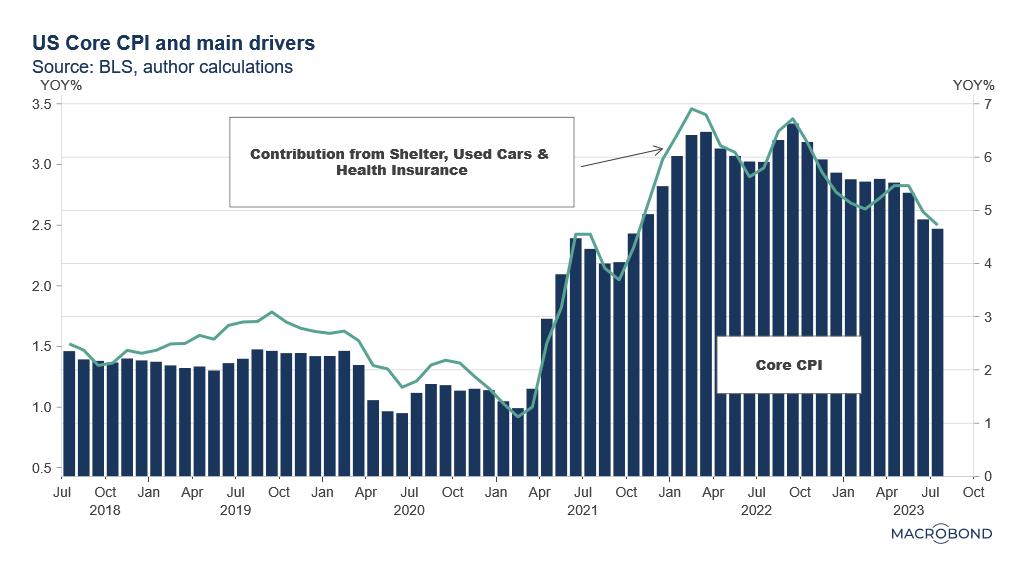
To be sure, job growth has been slowing, and for the past two months about half of the growth came from only one sector (health care). Part-time job growth was stronger than full-time for both months. Yet, labour markets are still tight; wage growth between 4 percent and 6 percent remains well above Chair Powell’s stated target of 3 percent.
Retail sales, even adjusted for inflation, are slower but resilient – led by online shopping, eating out, and autos. Despite slowing corporate loan demand and tighter lending standards, credit markets have good fundamentals and investor demand is supporting high yield spreads. Low equity-market volatility and falling interest-rate volatility are probably helping.
The enthusiasm for stocks exposed to artificial intelligence has also helped market sentiment, with the “Magnificent 7” (Alphabet, Amazon, Apple, Meta, Microsoft, NVIDIA, and Tesla) leading the way. Short sellers, who had taken a record position, are now in retreat, according to CME futures, and hedge-fund exposure to the Magnificent 7 is reportedly at record highs.
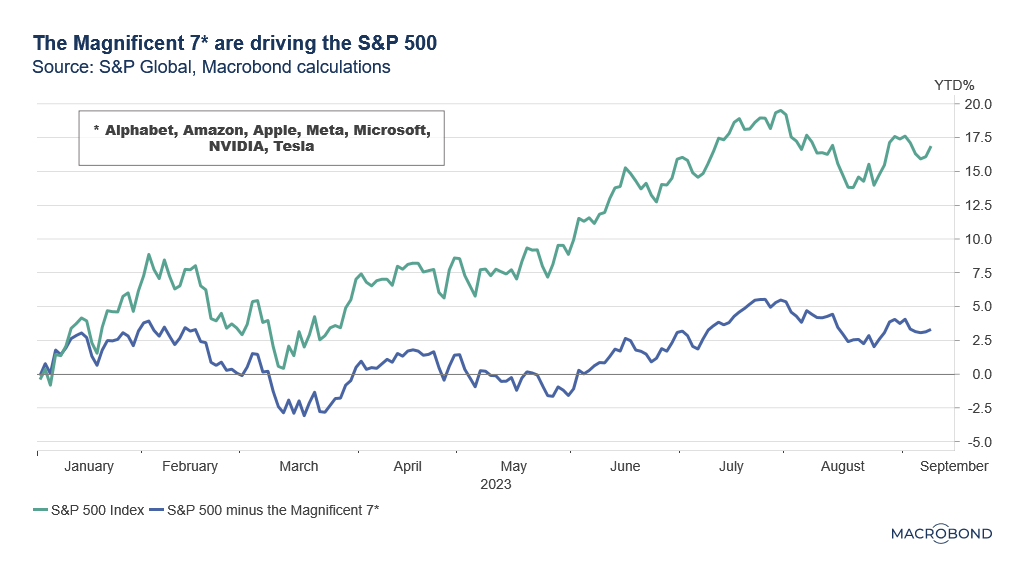
Stocks also appear to be beating the expected downdraft from global quantitative tightening. The next chart compares the S&P 500’s outperformance to a Macrobond model that correlates historic performance to central banks’ balance sheets.
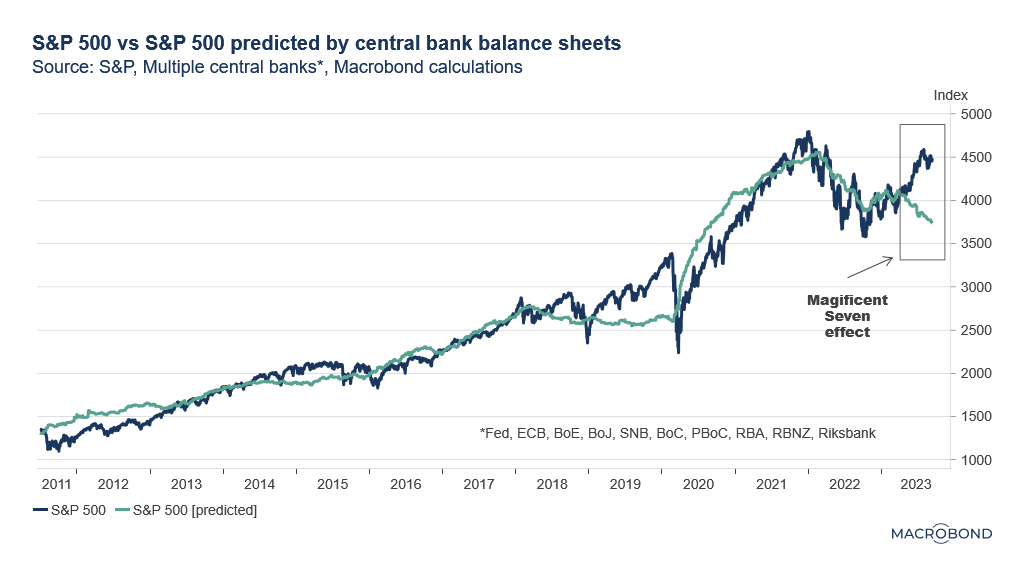
The US rate outlook
Fed fund futures now imply the central bank is more or less finished raising rates for the year, but still price in about four cuts next year. Meanwhile, two-year yields also imply that about four rate cuts will come eventually – but they still reflect the “higher for longer” case by trading well above the neutral “longer-run” target as of this writing. (Note that 2-year yields largely reflect the expected policy rate averaged over the next 2 years.)
Meanwhile, the yield curve remains inverted at record levels, which would normally imply a high probability of recession instead of a soft-landing.
However, many of those who predicted recession are changing their minds. Even the ECB has questioned the continued power of this recession signal; some researchers have pointed out that the post-2008 quantitative easing bond purchases by the Fed suppressed 10-year yields, accelerating the inversion of 2-year versus 10-year yields.
Japan’s lingering deflation concern
Turning to Japan, we see an economy that is also experiencing significant inflation – but with policy makers still focused on past decades’ deflationary trends.
As we noted last month in “Japan’s inflation revolution,” the country appears to be a net beneficiary from inflation. Nominal GDP, wages and corporate revenues are growing at the fastest rate in 30 years, while the global semiconductor shortage has triggered a tech sector renaissance. Capital spending could hit a record soon. The Nikkei 225 remains close to multi-decade highs.
Yet policymakers still worry about deflation, even with effective inflation over 4 percent and a labour market so tight that companies give forward guidance on workers’ future wages.
In the western world, such a tight labour market would have already raised concerns about inflation. However, the BOJ appears to be more lenient due to its long-term goals. In a speech last year, previous governor Haruhiko Kuroda cited concerns about Japan’s “zero-inflation norm”: for decades, companies were terrified of raising prices and losing market share.
To break this paradigm, Kuroda suggested 1) a roughly 2 percent “constant contribution” to CPI from services, supported by goods inflation cyclically fluctuating around 2 percent, and 2) labour market tightness sustained for a “long period.”
Approaching Kuroda’s target
What is the service contribution to CPI now? It’s rising, but is at 1 percent – below the 2 percent target, as the next graph shows*. Meanwhile, the goods contribution is currently around his target of 2 percent, but would be closer to 3 percent if energy subsidies were excluded.
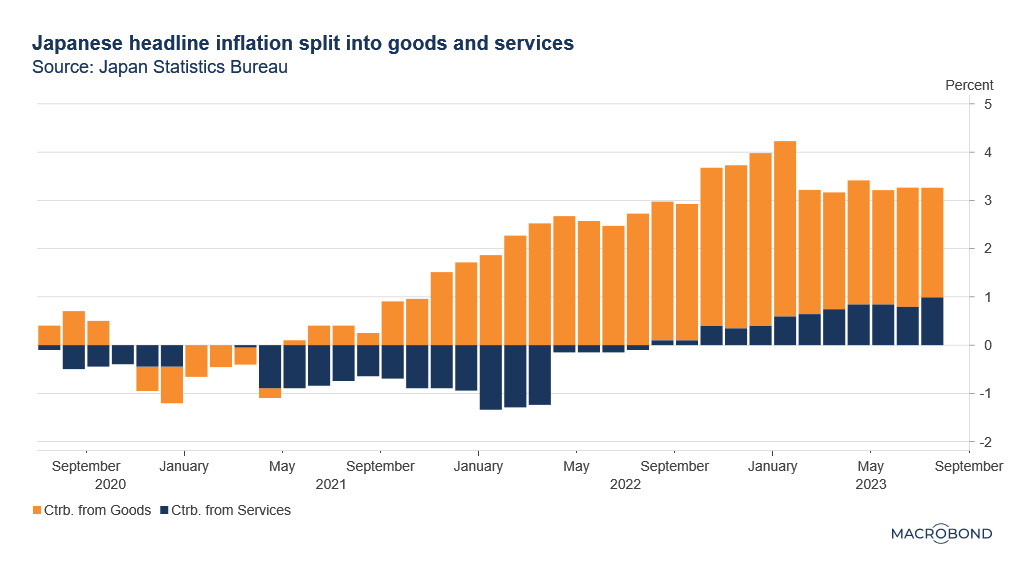
How about the corporate fear of hiking prices? It may be broken, at least according to the Tankan corporate survey shown in the next chart. Corporate behaviour is driving the trimmed mean version of inflation (which cuts the top and bottom 10 percent of price changes to reduce noise).
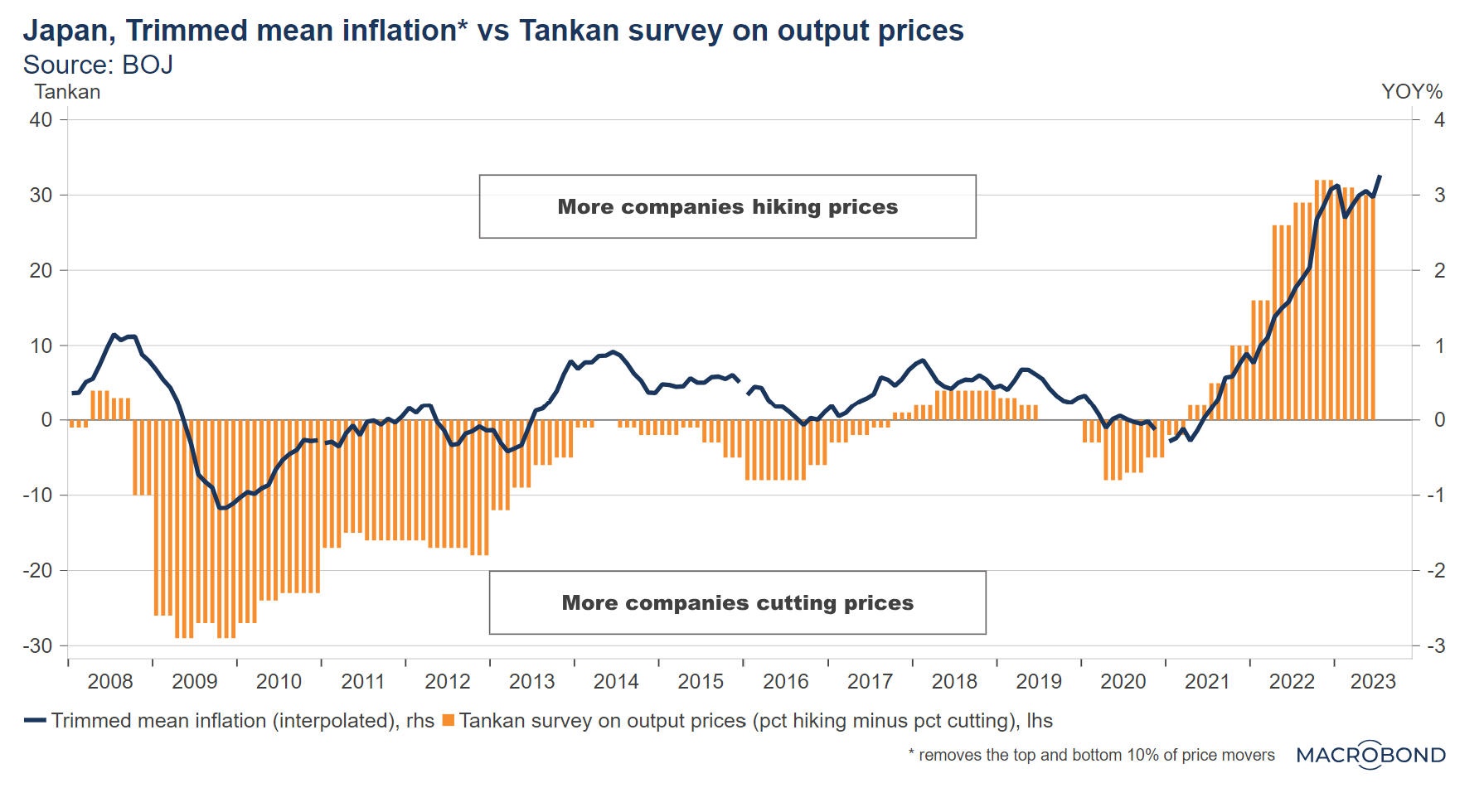
The rapidly shrinking spread between the producer price index and the consumer price index is yet another sign of increased corporate pricing power.
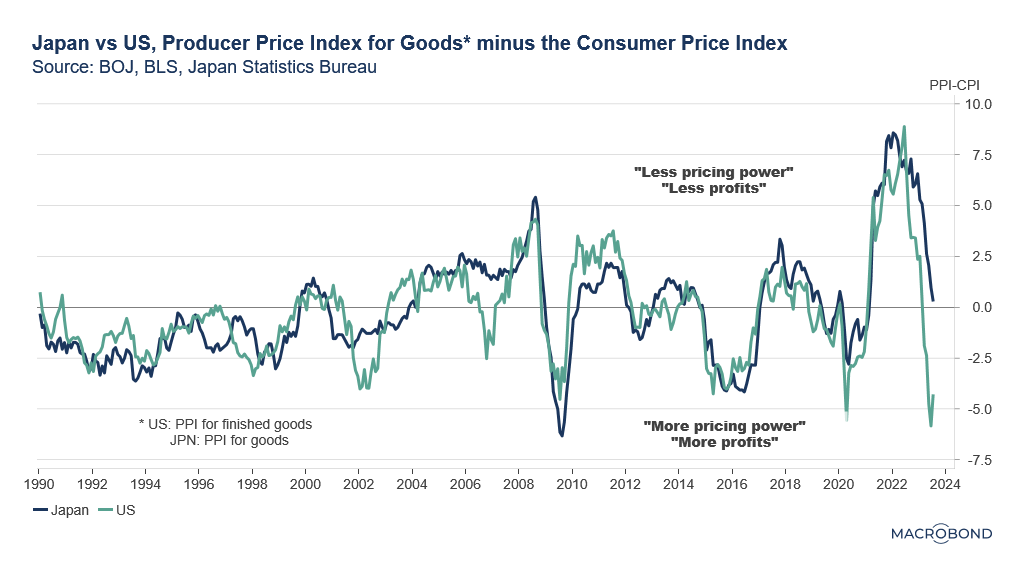
Tweaking yield curve control
At the end of July, Kazuo Ueda, Kuroda’s successor as governor, effectively loosened the BOJ’s “yield curve control” cap on 10-year yields from 0.5 percent to 1.0 percent. Interestingly, this sparked an increase in corporate bond issuance, as investors found more buyers for long-term bonds. A kink in the yield curve at around the 10-year tenor has also disappeared.
Thus, it appears that Ueda achieved his goal of improving the functioning of the bond market. The smaller 10-year rate differential with the US also slowed the weakening of the yen, which had been driving inflation via import prices of food and energy. Officially, the tweak made yield curve control (YCC) more sustainable.
Ueda’s comments since July have been dovish, implying “lower for longer” policy rates. However, this contrast to US policy has tended to weaken the yen, eventually fanning import inflation in Japan’s inflation drivers: the nation imports about 70 percent of its calories and 80 percent of its energy.
Speculation that change is coming
Thus, the market is increasingly speculating about the prospects for 1) normalised BOJ policy – meaning a “lift-off” or an end to negative policy rates, or 2) another round of foreign-exchange market intervention between 145-150 yen, similar to the one seen about a year ago in this chart:
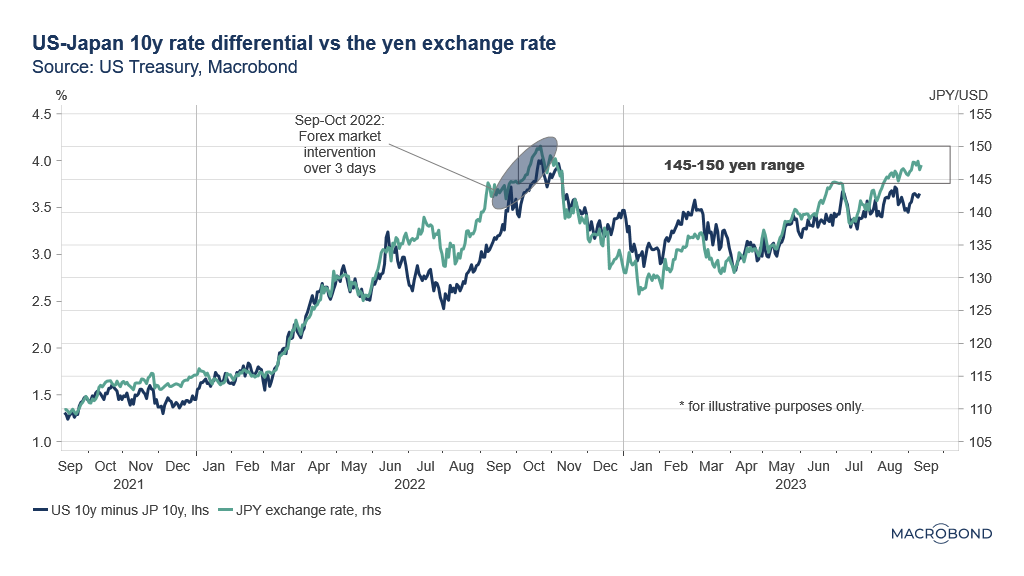
An unusually large hike in the BOJ’s FY2023 inflation outlook (from 1.8 percent in April to 2.5 percent in July) has also stirred expectations about an end to negative rates – as have comments from Naoki Tamura, a BOJ policy board member and former banking executive. On Aug. 30, he said that the BOJ’s 2 percent inflation target is “in sight,” and lifting off from negative rates while keeping the policy rate low would still be an accommodative policy.
Data to determine whether the 2 percent inflation target is attainable – making lift-off an option – “could be ready around January to March 2024,” he noted.
Similarly, on August 16, in an interview with Kyodo News, the head of markets at MUFG said that “a lift-off (normalisation) decision could come as early as January to March 2024.” Most recently, on September 6, BOJ policy board member and former economist Hajime Takata said: "Personally, I believe Japan's economy is finally seeing early signs of achieving the BOJ's 2 percent inflation target."
As for the yen? This year’s weakening from around 130 to 145 against the USD is much less drastic than last year’s move from around 115 to 150. Nevertheless, a prolonged weakening could eventually become a source of “bad” or “cost-push” inflation. A breather from this phenomenon would be widely welcomed.
*Former Governor Kuroda was probably referring to Core CPI, meaning Headline CPI excluding fresh food, but the difference with Headline CPI is negligible.
Recent pieces by this author
Why US inflation will slow and help the BOJ
As Ueda takes the helm of the Bank of Japan, do record wage hikes finally portend “good inflation?”
This article was published in conjunction with Japan Exchange Group (JPX) and the original can be found here.
2 topics
.png)
Macrobond delivers the world’s most extensive macroeconomic & financial data alongside the tools and technologies to quickly analyse, visualise and share insights – from a single integrated platform. Our application is a single source of truth for...
Expertise
.png)
Macrobond delivers the world’s most extensive macroeconomic & financial data alongside the tools and technologies to quickly analyse, visualise and share insights – from a single integrated platform. Our application is a single source of truth for...
.png)